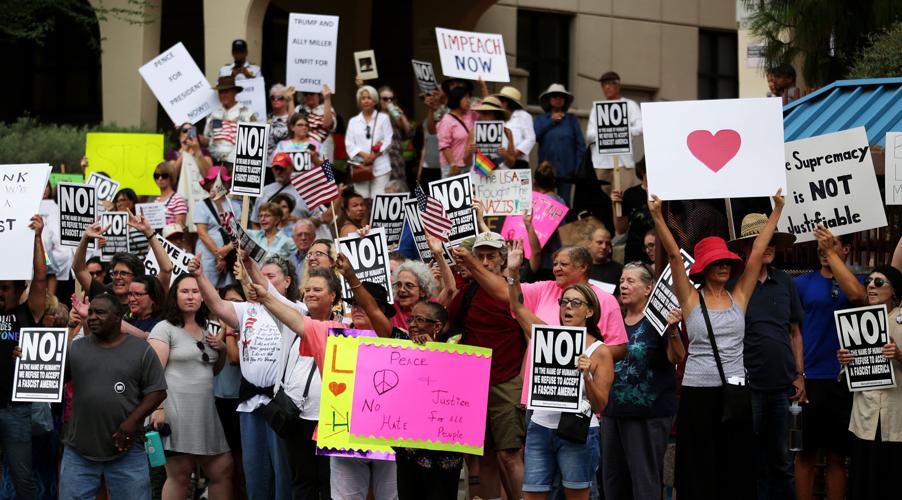Yes, an anti-Trump march is scheduled in Tucson Saturday.
No, it is not the beginning of a civil war.
If you know what I’m talking about, you probably are connected to the online world of political conspiracies and crazies. If you don’t, congratulations on living in reality.
For months, a group called Refuse Fascism has been promoting Nov. 4 as the start date of protests against the Trump administration. The group says it wants to overthrow the Trump presidency. Their inimitable slogan goes, “This Nightmare Must End: The Trump/Pence Regime Must Go!”
Protests are planned in 20 cities, if you count Pittsfield, Mass., population 42,846, and Omak, Wash., population 4,833.
Naturally, right-wing conspiracists have linked the protests to black-clad Antifa protesters and said that Nov. 4 protests are intended as the start of civil war between Trump supporters and opponents.
The most prominent conspiracist website, Alex Jones’ Infowars, interpreted the protest plans this way: “Antifa is planning a new round of nationwide riots on November 4 as part of a plot to start a ‘civil war’ that will lead to the overthrow of the Trump administration.”
Online, thousands of Americans on the Trump-supporting right have gotten angry and threatened violence. Searching the hashtag “civilwar2017” brings up many hair-raising threats against the protesters.
But this is really a more peculiar conflict than it at first appears because the protests are a creation of a relatively small group of far-left activists. Among the national organizers are members of the Revolutionary Communist Party USA, a strange, cult-like political group with a secretive leader, Bob Avakian, known as “Chairman Bob.”
And that’s one of the reasons why it’s unlikely to become a broad-based protest movement. This is the sharp left edge of anti-Trump activity, not the heart of anti-Trump opinion, which is centered in the boring old Democratic Party.
Even Chuck Kaufman, whose Tucson-based group the Alliance for Global Justice acts as a fiscal agent for groups involved in the movement, told me he was unaware there is a Refuse Fascism march in Tucson.
Also, Refuse Fascism organizers swear they are advocating only non-violent protest. This is how the organizers of the Tucson protest put it on their Facebook page:
“There are NO plans for any civil disobedient actions. We are encouraging peaceful march, and any violent actions will not be supported or endorsed by us. Please act with common sense and safety knowing that children will likely be present.”
The Tucson march is scheduled to begin at the Tucson Convention Center, where the local Comic Con gathering will be occurring this weekend, at 2 p.m. Saturday. It’s likely to be outnumbered both by Comic Con attendees and maybe even by the Procession of Little Angels, a Saturday afternoon prelude to Sunday’s All Souls Procession at Armory Park.
For now, even though the idea is that these protests will gather strength and end the Trump presidency, it is the only Refuse Fascism event planned in Arizona, with nothing more scheduled beyond Saturday.
McSally 2nd for Senate
Two polls out recently suggest that if Rep. Martha McSally runs for the GOP nomination for U.S. Senate, she will be the main challenger to candidate Kelli Ward.
The Tucson congresswoman has still not said whether she will run for the seat Sen. Jeff Flake is leaving, but she is clearly considering it. And the two polls suggest she could be in a decent position to win.
Data Orbital polled 500 Republicans Oct. 26-28 and found “undecided” was the favored pick, representing 28 percent of respondents. Ward was the 2nd-ranked pick, with 26 percent. McSally was third, with 19 percent.
After that, came Matt Salmon with 10 percent, David Schweikert with 5 percent, John Shadegg with 4 percent and Jay Heiler with 1 percent.
Another poll, conducted for Ward using less credible methods, surveyed 380 likely GOP primary voters. They, too, favored “undecided,” the pick of 34 percent of respondents. Ward won the nod of 32 percent of those surveyed, and McSally got 21 percent.
Salmon polled at 9 percent, and minor candidates Craig Brittain and Nicholas Tutora got 4 and 2 percent.
The upshot: If McSally were to clear the field of other big-name Republicans, like Salmon and Schweikert, she could become the leading contender.
Garcia’s governor plan
If things had turned out as he planned, Democrat David Garcia would be running for governor this year as Arizona’s incumbent superintendent of public instruction. But Garcia, an Arizona State University professor of education, unexpectedly lost to Republican Diane Douglas.
So, instead, Garcia is running for the Democratic nomination as an outsider, a non-politician in an era in which, after all, Donald Trump the non-politician occupies the White House. Garcia told me about his plans a couple of weeks ago when passing through town.
He is running, of course, against Sen. Steve Farley, the Tucson Democrat, for the chance to challenge Republican Gov. Doug Ducey.
The key, Garcia said, will be turnout. He said he ran a “persuasion” campaign in 2014, when he lost by 16,034 votes, or 1 percent of those cast in the race, to Douglas. This year, if he wins the nomination, he’ll run an “engagement” campaign, intended to spike turnout to make up for a 200,000 voter shortfall in the Democratic base.
“If we don’t expand those numbers in a meaningful way, we can’t make up the difference,” he said.
Motivated OV voters
I wrote for Wednesday’s paper about the passionate politics of Oro Valley, where voters are considering the town’s first property tax to pay for a $17 million development of Naranja Park.
How passionate are they? As of Thursday, County Recorder F. Ann Rodriguez said, 61 percent of those Oro Valley voters who received mail-in ballots had returned them. That’s 13,661 out of 22,407 mail-in ballots sent out.
Those returned ballots amount to 44 percent of the 30,745 total registered voters in Oro Valley. And by the way, OV is a predominantly GOP town. Of all the registered voters, 13,092, or 43 percent, are Republicans; 9,236, or 30 percent, are independents; and 8,181, or 27 percent, are Democrats.





